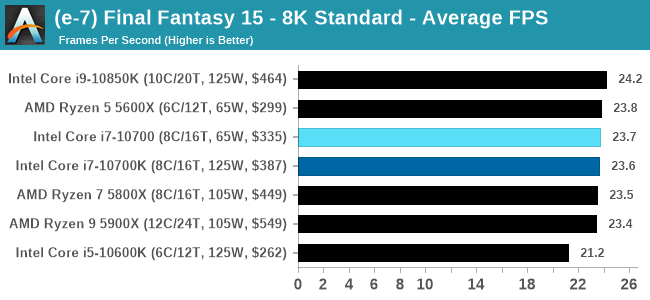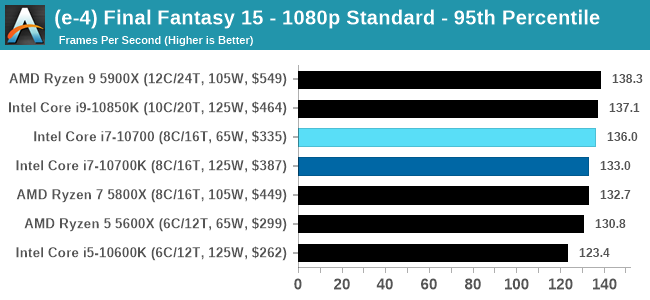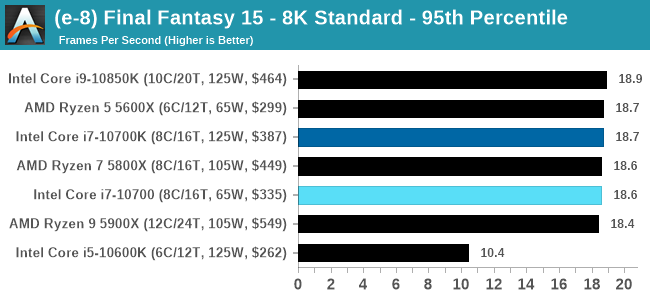Intel Core i7-10700 vs Core i7-10700K Review: Is 65W Comet Lake an Option?
by Dr. Ian Cutress on January 21, 2021 10:30 AM EST- Posted in
- CPUs
- Intel
- Core i7
- Z490
- 10th Gen Core
- Comet Lake
- i7-10700K
- i7-10700
Gaming Tests: Final Fantasy XV
Upon arriving to PC, Final Fantasy XV: Windows Edition was given a graphical overhaul as it was ported over from console. As a fantasy RPG with a long history, the fruits of Square-Enix’s successful partnership with NVIDIA are on display. The game uses the internal Luminous Engine, and as with other Final Fantasy games, pushes the imagination of what we can do with the hardware underneath us. To that end, FFXV was one of the first games to promote the use of ‘video game landscape photography’, due in part to the extensive detail even at long range but also with the integration of NVIDIA’s Ansel software, that allowed for super-resolution imagery and post-processing effects to be applied.
In preparation for the launch of the game, Square Enix opted to release a standalone benchmark. Using the Final Fantasy XV standalone benchmark gives us a lengthy standardized sequence to record, although it should be noted that its heavy use of NVIDIA technology means that the Maximum setting has problems - it renders items off screen. To get around this, we use the standard preset which does not have these issues. We use the following settings:
- 720p Standard, 1080p Standard, 4K Standard, 8K Standard
For automation, the title accepts command line inputs for both resolution and settings, and then auto-quits when finished. As with the other benchmarks, we do as many runs until 10 minutes per resolution/setting combination has passed, and then take averages. Realistically, because of the length of this test, this equates to two runs per setting.
| AnandTech | Low Resolution Low Quality |
Medium Resolution Low Quality |
High Resolution Low Quality |
Medium Resolution Max Quality |
| Average FPS |  |
 |
 |
 |
| 95th Percentile |  |
 |
 |
 |
All of our benchmark results can also be found in our benchmark engine, Bench.












210 Comments
View All Comments
schujj07 - Friday, January 22, 2021 - link
A stock 3700X has a total package power of 88W and the 212 EVO is a 150W TDP cooler. Whereas the included Wraith Prism cooler with the 3700X is a 125W TDP cooler. One would expect that the larger capacity cooler with the larger fan would be quieter.vegemeister - Friday, January 22, 2021 - link
Heat transfer does not work that way.ΔT = P * R
where T is temperature (K), P is power (W), and R is thermal resistance (K/W).
Unless the temperature rise is known the only thing "150W cooler" tells you is that the heat pipes won't dry out at 150W with reasonable ambient temperature. (That's a thing that can happen. It's not permanent damage, but it does mean R gets a lot bigger.)
The fact is the Wraith Prism is the same 92mm downdraft cooler AMD has been shipping with their CPUs since the Phenom II 965.
Spunjji - Friday, January 22, 2021 - link
The Wraith Prisms are fine - the one that comes with the low-end ryzens (and I think now the 5600) aren't so great for noise, but they do let the CPU come within 95% of its peak performance, so not bad for a freebie.alufan - Thursday, January 21, 2021 - link
Am not seeing the point of this article is 65w an option and then you blatantly ignore the actual TDP stated and produce a test, for the test to be a fair comparison all the chips should be limited to actual power stated and then run through any Benchmarks, its like saying we are testing CPUs at 125w and including the LN2 FX AMD chip and seeing how much power you can actually run through it, running these chips like this constantly will degrade them and eat up a considerable amount of power that you dont need to use.Then again I should be surprised, yet again 12 articles on the front page regarding Intel 3 regarding AMD guess Intels media budget is bigger hmm
DominionSeraph - Thursday, January 21, 2021 - link
It's AMD CPUs that degrade at stock clocks. Intel will run for decades even with moderate overclocks.bji - Thursday, January 21, 2021 - link
AMD CPUs do not "degrade" at stock clocks or overclocks.DominionSeraph - Thursday, January 21, 2021 - link
Their Turbo is literally built around it. It will lower clocks as the chip degrades. The degradation is all over Reddit. I'm surprised no tech site has followed up on the scandal.bigboxes - Thursday, January 21, 2021 - link
I'm surprised there aren't more trolling like youSpunjji - Friday, January 22, 2021 - link
I'm not.I just spent a bit of time on Google and the majority of the results are people saying "I heard this, is it true?" - the rest are people talking about how they ran their chip way outside spec (significant overvoltage, overclock *and* high temperatures) and can no longer get the same overclock out of it.
Take your FUD and cram it. 🥰
Spunjji - Friday, January 22, 2021 - link
It took me less than 15 minutes to confirm that this is a lie.Incidentally, the only CPUs I've ever had "degradation" problems with were all Sandy Bridge - 2 i3s, one i5 and one i7. Only one of them was ever overclocked. They started to show strange issues after 3-5 years - stuff like frame-rate inconsistency in games, graphics artefacts, random crashes.
I've never gone around slamming Intel, though, because sometimes you just get a bad chip. It happens.